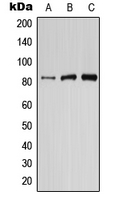Anti-PIK3R6 Antibody
- SPECIFICATION
- CITATIONS
- PROTOCOLS
- BACKGROUND

Application
| WB |
|---|---|
| Primary Accession | Q5UE93 |
| Reactivity | Human, Mouse, Rat |
| Host | Rabbit |
| Clonality | Polyclonal |
| Calculated MW | 84258 Da |
| Gene ID | 146850 |
|---|---|
| Other Names | C17orf38; Phosphoinositide 3-kinase regulatory subunit 6; Phosphoinositide 3-kinase gamma adapter protein of 87 kDa; p84 PI3K adapter protein; p84 PIKAP; p87 PI3K adapter protein; p87PIKAP |
| Target/Specificity | Recognizes endogenous levels of PIK3R6 protein. |
| Dilution | WB~~1/500 - 1/1000 |
| Format | Liquid in 0.42% Potassium phosphate, 0.87% Sodium chloride, pH 7.3, 30% glycerol, and 0.09% (W/V) sodium azide. |
| Storage | Store at -20 °C.Stable for 12 months from date of receipt |
| Name | PIK3R6 |
|---|---|
| Synonyms | C17orf38 |
| Function | Regulatory subunit of the PI3K gamma complex. Acts as an adapter to drive activation of PIK3CG by beta-gamma G protein dimers. The PIK3CG:PIK3R6 heterodimer is much less sensitive to beta-gamma G protein dimers than PIK3CG:PIK3R5 and its membrane recruitment and beta-gamma G protein dimer-dependent activation requires HRAS bound to PIK3CG. Recruits of the PI3K gamma complex to a PDE3B:RAPGEF3 signaling complex involved in angiogenesis; signaling seems to involve RRAS. |
| Cellular Location | Cytoplasm {ECO:0000250|UniProtKB:Q3U6Q4}. Cell membrane {ECO:0000250|UniProtKB:Q3U6Q4}; Peripheral membrane protein {ECO:0000250|UniProtKB:Q3U6Q4}. Note=Translocated to the plasma membrane in a Ras-dependent manner. {ECO:0000250|UniProtKB:Q3U6Q4} |

Thousands of laboratories across the world have published research that depended on the performance of antibodies from Abcepta to advance their research. Check out links to articles that cite our products in major peer-reviewed journals, organized by research category.
info@abcepta.com, and receive a free "I Love Antibodies" mug.
Provided below are standard protocols that you may find useful for product applications.
Background
Rabbit polyclonal antibody to PIK3R6
If you have used an Abcepta product and would like to share how it has performed, please click on the "Submit Review" button and provide the requested information. Our staff will examine and post your review and contact you if needed.
If you have any additional inquiries please email technical services at tech@abcepta.com.













 Foundational characteristics of cancer include proliferation, angiogenesis, migration, evasion of apoptosis, and cellular immortality. Find key markers for these cellular processes and antibodies to detect them.
Foundational characteristics of cancer include proliferation, angiogenesis, migration, evasion of apoptosis, and cellular immortality. Find key markers for these cellular processes and antibodies to detect them. The SUMOplot™ Analysis Program predicts and scores sumoylation sites in your protein. SUMOylation is a post-translational modification involved in various cellular processes, such as nuclear-cytosolic transport, transcriptional regulation, apoptosis, protein stability, response to stress, and progression through the cell cycle.
The SUMOplot™ Analysis Program predicts and scores sumoylation sites in your protein. SUMOylation is a post-translational modification involved in various cellular processes, such as nuclear-cytosolic transport, transcriptional regulation, apoptosis, protein stability, response to stress, and progression through the cell cycle. The Autophagy Receptor Motif Plotter predicts and scores autophagy receptor binding sites in your protein. Identifying proteins connected to this pathway is critical to understanding the role of autophagy in physiological as well as pathological processes such as development, differentiation, neurodegenerative diseases, stress, infection, and cancer.
The Autophagy Receptor Motif Plotter predicts and scores autophagy receptor binding sites in your protein. Identifying proteins connected to this pathway is critical to understanding the role of autophagy in physiological as well as pathological processes such as development, differentiation, neurodegenerative diseases, stress, infection, and cancer.


